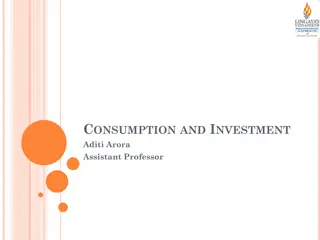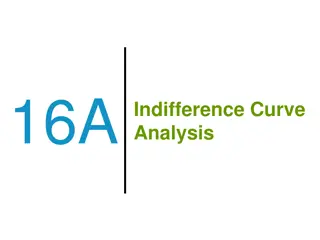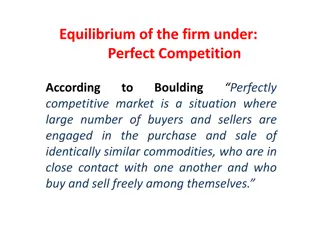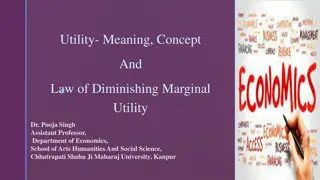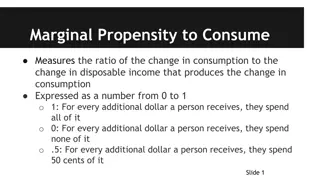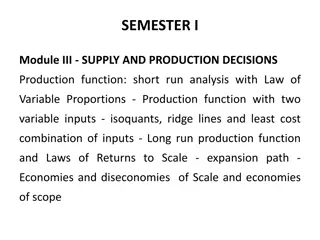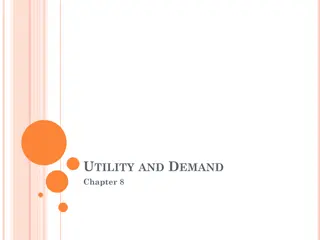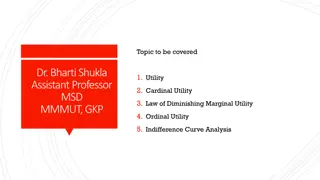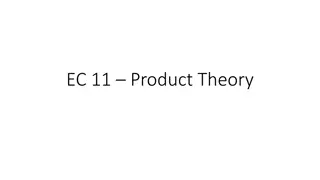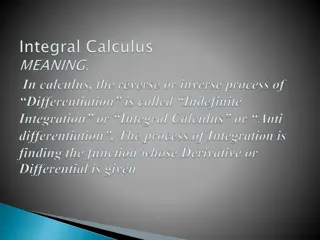Understanding Utility and Marginal Utility in Economics
Utility refers to the satisfaction a consumer receives from consuming commodities. It is a subjective concept that can be measured through cardinal or ordinal approaches. Cardinal approach involves measuring utility numerically, while ordinal approach orders levels of satisfaction based on utility. The relationship between total utility and marginal utility is crucial in understanding consumer behavior and decision-making in economics.
Download Presentation

Please find below an Image/Link to download the presentation.
The content on the website is provided AS IS for your information and personal use only. It may not be sold, licensed, or shared on other websites without obtaining consent from the author. Download presentation by click this link. If you encounter any issues during the download, it is possible that the publisher has removed the file from their server.
E N D
Presentation Transcript
UTILITY AND MARGINAL UTILITY ANKITA VERMA DEPT. OF COMMERCE DURGA COLLEGE, RAIPUR
Overview Meaning of Utility Definition Characteristics of utility Measurement of utility Cardinal approach Ordinal approach Kind of utility Total Utility- Marginal utility Form of Marginal Utility Diagrammatic Representation Relationship Between MU AND TU
Meaning of Utility The Satisfaction that a Consumer receives from consuming Commodities is called Utility. In other words Utility is the amount of satisfaction derived from the consumption of a commodity
Definition According to Daniel Bernoulli According to Daniel Bernoulli - - The amount to which an economic good or product benefits a consumer s demand or need determines its utility .
Characteristics of utility Utility is a relative term No physical shape It is not concern with usefulness or welfare It depends on the intensity of wants It does not depend on actual consumption It induces consumers to buy commodity It can not be acquired without sacrifice
Measurement of utility There are two approach 1. Cardinal approach By Marshall 2. Odinal approach By Hicks, Allen, Pareto
Cardinal approach Marshall has talked about measuring utility through money. According to him, the approach of measuring utility is numerical, because in this utility is counted, like 1,2,3,4,5 etc. These numbers show that the number 5 is five times greater than the number 1. In the context of measuring utility on the scale of money, Marshall has said that the price one is willing to pay for a unit of a commodity rather than being deprived of the consumption of a unit of that commodity, is the same a the amount of money that can be obtained from that commodity . Value is the monetary measure of utility.
Ordinal approach Hicks Allen economists introduced an alternative to the enumerative approach called the ordinal approach. According to this view, utility is a subjective idea which cannot be made objective. In other words, utility is a psychological concept that varies from person to person. It cannot be measured by giving a numerical score. According to ordinal approach, the levels of satisfaction can be given a definite order on the basis of utility. The consumer can tell whether a certain unit of another commodity, but he cannot tell how much is the difference between the two satisfactions, Economists who follow ordinal approach do not even agree on measuring utility through money because in their view the measure of money is no t stable and fixed. A D J F K D J F K
Kind of utility Utility can be divided into two parts- 1. Total utility 2. Marginal Utility
Total Utility- The overall level of satisfaction derived from consuming a good or service. It may be defined as the sum of the utility derived from each unit consumed of the commodity. If consumer consumes four units of a commodity derives U1, U2,U3, U4 utils from the successive units consumed, then TU = U1+U2+U3+U4
Marginal utility (MU)- Additional satisfaction that an individual derives from consuming an additional unit of a good or service. It is the addition to TU derived from consuming an additional unity of commodity. Formula: MU = Change in total utility Change in quantity
Form of Marginal Utility Forms of Marginal Utility The concept of marginal utility has been explain in table no. 1. NO OF BREAD TOTAL UTILITY (TU) MARGINAL UTILITY (MU) 1 2 3 4 5 6 7 8 25 45 60 70 75 75 70. 60 25 20 15 10 5 0 -5 -10 Positive Marginal Utility Zero Marginal Utility Negative Marginal Utility Table no.1 Marginal and Total Utility
Three forms of Marginal Utility From the above table it is clear that Marginal Utility has three form 1. Positive Marginal Utility When the TU of a commodity increase by the sum of the marginal utility derived from the consumption of successive units, the MU of the commodity is positive. According to the table, marginal utility is positive up to the fifth unit of bread. 2. Zero Marginal Utility The Marginal Utility of the consumption on the sixth unit is zero and the TU is 75. 3. Negative Marginal Utility According to the table, when the seventh unit of bread is consumed, its utility becomes negative. On the seventh unit, his MU decreases to -5 and TU to 70. Consumption of eighth unit reduces MU to -10 and TU remains 60.
Diagrammatic Representation Y axis 80 MU & TU 70 60 50 40 TU 30 MU 20 10 1 0 100 X axis 2 3 4 0 5Y -10 UNITS OF BREAD -20
Relationship Between MU AND TU 1. Marginal Utility decreases from the first unit to the sixth unit of bread, but some utility increases. Total utility increses in the same order as marginal utility decreases. 2. The consume gets full satisfaction on the sixth unit of bread. MU is zero at this point, while TU is maximum. The increase in total utility stops after the sixth unit of bread is consumed. 3. MU becomes negative after zero utility point i.e. after the point of complete satisfaction in such a situation, the TU also starts decreasing.



